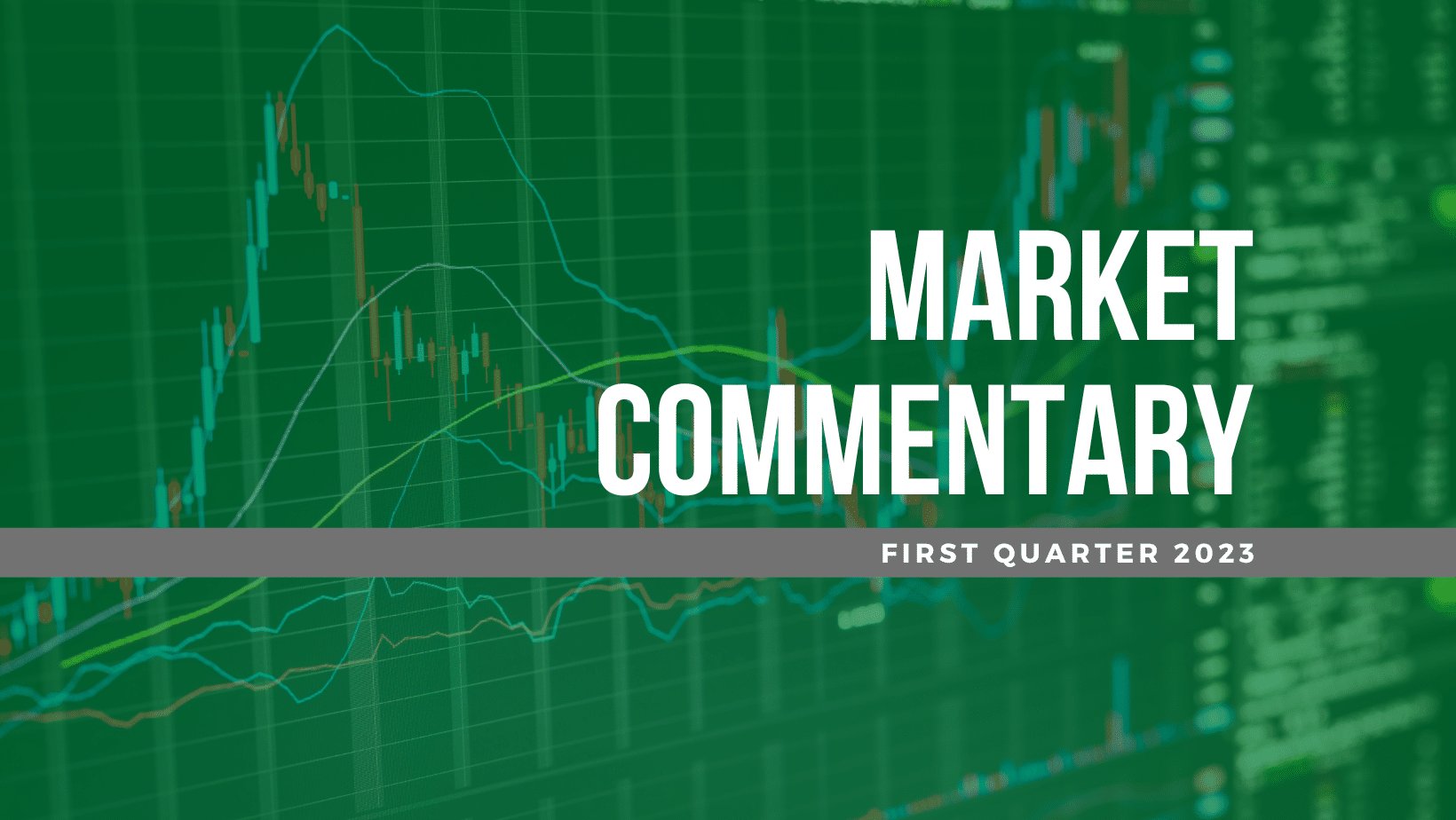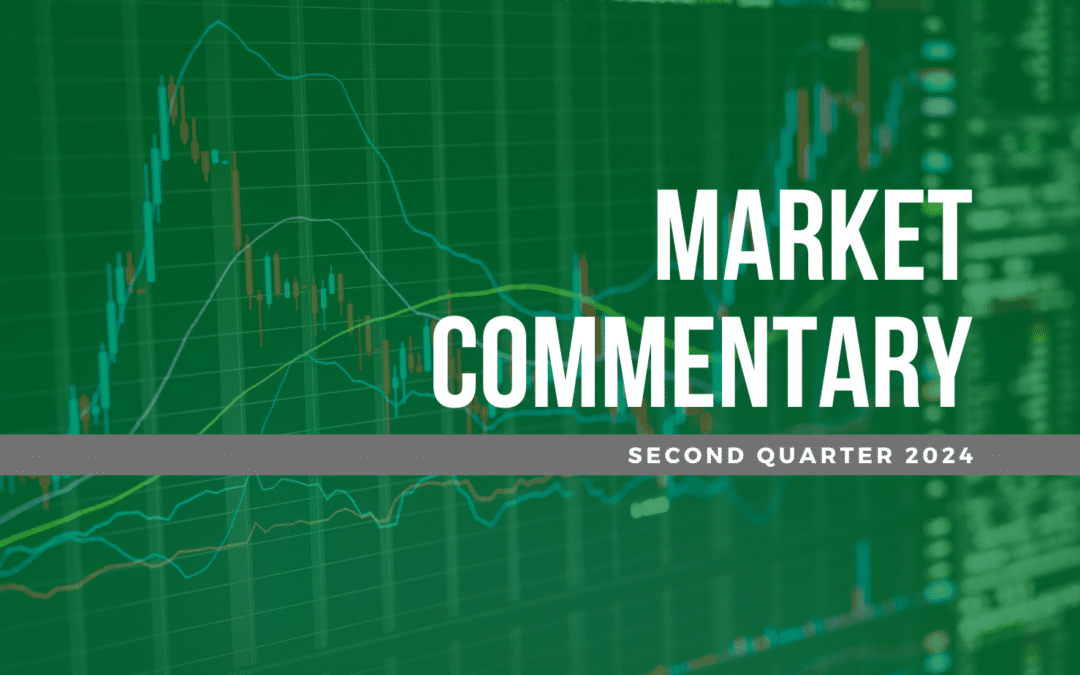Economic Overview
By Dr. Mark Pyles
The first quarter (Q1) of 2023 provided a roller coaster of emotions regarding the outlook for the US Economy. In the latter stages of 2022, a consensus narrative had developed and subsequently gained momentum as we entered the new year. One of the most intense rate hiking regimes in history had created a dramatic tightening of financial conditions. This, when coupled with a slowing economic backdrop in which they occurred, helped fuel the consensus opinion that the US Economy would necessarily experience a mild recession in 2023.
However, subsequent economic data caused doubt regarding this outcome and created the first abrupt lurch on our roller coaster ride. Following a robust GDP growth rate of 3.2% for Q3 2022 (which countered the first two quarters of slightly negative growth), the advance number for Q4 2022 came in at a similarly robust value of 2.9%. This was comfortably above expectations and suggested that ours did not appear to be an economy on the verge of recession that had seemed imminent to many just months prior.
The other half of the accepted consensus towards the end of 2022 was that inflation had peaked and was rapidly beginning its descent. Specifically, headline CPI was at 9.1% year-over-year (YoY) in June 2022, but had decreased to 6.5% YoY by December. The average month-over-month (MoM) inflation of headline CPI was 0.8% for the first six months of 2022, compared to only 0.2% in the last six months. Thus, we also had very positive momentum with inflation. With an economy that was holding up better than expected and inflation that appeared to be trending stoutly in the right direction, the growing new consensus was not one of a debate between a “soft” or “hard” landing, but whether a “no landing” scenario could occur.
However, the second major turn in the roller coaster came with the release of the January payroll report, which came in nearly three times the estimated amount at 517,000. The February print showed some moderation at just over 300,000 new jobs coupled with a modest adjustment downward of that January number. However, the approximately 800,000 jobs added during the first two months of 2023 further solidified the notion that the labor market remains very tight and running at a rate that can cause concern with persistent inflation.
These concerns were partially born out when the January CPI came in at 0.5% MoM and was accompanied by an upward revision in the December number as well. Core PCE (Personal Consumption Expenditure) – the Fed’s preferred gauge – followed suit at 0.6% MoM and 4.7% YoY. A month later, February’s data did little to ease concerns, with headline CPI coming in at 6.0% YoY and core PCE at 4.6%. As a reminder, the Fed has been steadfast in their pursuit of a 2% rate in this latter metric. Thus, these data resulted in the market rekindling a familiar fear – that the Fed would be forced to hike further, and remain at higher rates for longer, than we had anticipated. Futures priced in a 2023 year ending Fed Funds Rate in excess of 5.5% during the first week of March.
With all of this as backdrop, it is important to note that with each of these data items comes caveats. On the growth front, we are currently expecting reasonable growth quarter, with the Atlanta Fed’s GDPNow Forecast currently predicting 1.7% for Q1 2023. However, as with most data in recent times, these values will likely be subject to adjustment. For example, that advanced Q4 2022 GDP number mentioned earlier has been revised downward significantly from 2.9% to 2.6% with the final reading. Even more dramatic, personal consumption was revised downward from 2.1% to 1.0%. When we keep in mind that real average earnings have been negative since April 2021, the amount of revolving credit has increased by 25% over the same time period, and the savings rate is still far below historical norms, it is difficult to imagine that consumers can continue to support the economy at the same level going forward.
On the inflation data front, it is important to examine within segments. In March of 2022, Goods (ex-Food and Energy) contributed 2.4% YoY to headline CPI, while Energy alone added another 2.2%. Those numbers in February 2023 were 0.2% and 0.4%, respectively, clearly showing disinflation in those areas. On the other hand, Services inflation has been steadily increasing since August of 2021, when it stood at 1.6% YoY. In February, this number has ballooned to 4.2%, clear indication that the remaining problems within inflation lie in the services side of the economy.
We can dig deeper into this to add further clarity. Recently Fed Chairman Powell has elevated a more restrictive measure of inflation to the forefront of their considerations. The so-called “super core” of core services ex-shelter includes areas such as medical care, recreation, and transportation – and as such are clearly indeed “core” to a functioning economy. This value remains in excess of 6% YoY and is something the Fed is watching very clearly.
And then finally, some color is required in examining the labor market as well. Labor market data is always a lagged indicator of economic activity. This, combined with the knowledge that this data is based upon a survey with a steadily declining response rate, should give pause to those using it to suggest we should fear wage-driven inflation. In fact, it is difficult to sell the notion that wage growth is the primary driver of inflation pains, as wage gains have moderated from an average of 5.5% monthly for the first nine months of 2022 to an average of only 4.7% YoY in the five months reported thereafter – and remained lower than headline inflation metrics throughout.
Of course, one cannot end without mentioning the last and greatest loop-de-loop on the roller coaster. The spillover effects from the banking crisis in early March will be covered in later sections of these pages from a financial ramification perspective; however, the economic fallout is equally impactful. At a minimum, this provided dramatic evidence that the 450 basis points (4.5%) of rate increases to that point had indeed caused stress in at least some segments of the market.
The Fed did not fully receive this signal, as they added yet another 25 basis point hike on March 22nd, bringing the Fed Funds Rate to an upper limit of 5.0%. They did, however, soften their language regarding additional hiking to come and acknowledged considerable uncertainty around the outcome of the banking crisis. Therefore, as the roller coaster of economic emotions that was Q1 2023 ends, it is not as though we can truly say we are done. Rather, we must act as naïve children at Disney World and eagerly embark on our search for the next ride – whether our stomachs are truly up for it or not.
Internally, our perspectives have largely remained unchanged. We have long-felt the massive reduction in liquidity and increased tightness in financial conditions would necessarily result in economic pain – it is just a matter of the degree thereof. To that end, we do acknowledge upside risk to the magnitude has now developed because of the recent banking related failures. On the more positive side, we continue to believe that inflation will rapidly retreat despite the recent bumps in the road and are increasingly convinced that the Fed is near the end of its hiking campaign.
The Stock Market
By Walter Todd
Well, that was interesting. Dr. Pyles talked about the roller coaster ride in the section above and that definitely applies to the stock market so far in 2023. Please keep your seatbelt securely fastened. We started out sharply higher in January into a high on February 2nd before a “hot” jobs report on the following day started a downhill run that culminated with bank failures in the first two weeks of March. Just when it looked like we were headed lower, stocks ripped higher into the end of the quarter. The nuance underneath the surface of this first quarter is it was very much a mirror image of 2022. The worst became the best and vice versa. This was the case before the turmoil in March, but this market uncertainty catalyzed the move as investors rushed even further into the mega-cap Technology names (Apple, Microsoft, Alphabet, Amazon, Tesla, etc). In fact, the top seven names in the S&P 500 Index accounted for 82% of the total index return for the quarter. A different way to look at this dynamic is the difference in performance between the S&P 500, which is market-cap weighted, and the equal-weight S&P 500 (EW S&P 500). As the name implies, each constituent in this index has the same weight. The traditional S&P 500 Index was up 7.5% for the quarter while the EW S&P 500 was up just 2.9%. This spread indicates that the “average” stock did not do nearly as well as the larger names in the index. You will see this as well when we look more at sector performance in the paragraphs below. For now, let’s review the broader performance trends in the first quarter.
For the quarter, the S&P 500 Index closed up +7.5%, including dividends, for a second consecutive positive quarter. Small-cap stocks (as measured by the S&P 600) were positive but lagged their larger brethren, ending the quarter higher +2.5%. International stocks posted another strong quarter as the US Dollar (USD) continued to weaken. Developed International Markets rose by +8.7% for the quarter (as measured by the EAFE Index). Emerging Markets (EM) were not as robust but still gained +4.0% for the quarter (measured by the MSCI Emerging Market Index). Putting the US and International Markets together, the MSCI All-Country World Index (ACWI) finished up by +7.4% for the three-month period.
In the US market, while 7 of 11 sectors were positive for the quarter, only 3 of 11 outperformed the overall market. There was Technology, Communications Services and Consumer Discretionary and then everything else. These three sectors were all up over 16% for the three-month period, with Technology and Comm. Services up over 20%. Not coincidentally, the top 5 names in the S&P 500 all happen to be in these three sectors (see discussion in the first paragraph). As you might guess given the banking failures during the quarter, Financials were at the bottom of sector performance, falling more than 5% for the period. Utilities, Healthcare and Energy were not far behind, dropping between 3-5%. Consumer Staples, Real Estate, Industrials and Materials were in the middle of the pack rising between 1 to 4%. In many respects, from a sector perspective, the first quarter of 2023 looked like the opposite of 2022 where Technology, Consumer Discretionary and Communication Services were the worst three performing sectors, plunging between 28-40% and Energy was at the top, rising over 65%. As Jerry Seinfeld might say, a Bizarro World.
I must admit that as I reflect back on what has transpired over the past three months, I’m surprised by how resilient the stock market has been. We highlighted some of the unique factors that have driven this performance, including the significant influence of the larger names on overall performance. Nevertheless, the proverbial kitchen sink has been thrown at this market and overall, it has held its own. Of course, there are two sides to every coin and another view is that perhaps the market may be whistling by the graveyard given what will likely be slower economic growth and increased downward pressure on earnings as we move through the remainder of 2023. We are thankful for the performance year-to-date but remain on guard for the other side of the coin. From a positioning standpoint, we certainly did not have enough exposure to the mega-cap technology names that drove the performance in the first three months of the year, but we are comfortable with our weighting there going forward. We remain overweight Healthcare as our preferred defensive play. We are underweight Financials and banks and have been for the past year. While we are on the lookout for opportunities here created by the disruption from SVB, we will likely maintain this positioning.
We will close this section with a few facts about historical performance. As we enter the month of April, it’s worth noting that since 1950, this has historically been the second-best performing month of the year (behind January) in pre-election years, rising by over 3% during these periods. We also have the S&P 500 rising over 7% in the first quarter of the year. Since 1950, this has happened on 16 other occasions. In each of the years, the market has ended higher for the year, by an average of 23.1%. Of course, past performance may not be indicative of future results, but there are some historical tailwinds given this backdrop.
The fixed income market posted a second consecutive positive quarter as turmoil in the banking system drove investors to the safety of US Treasury bonds. While there has been some relief due to the support offered by the Treasury Department and other government agencies, the bond market is looking ahead and suggesting that the Federal Reserve is at the end of this cycle for raising the Fed Funds Rate. In fact, the 2-Year Treasury Note yield, which historically leads monetary policy, is 100 basis points (1.00%) below the Federal Funds Rate. This has been the case only two other times in the past 30 years – just before the recession periods in 2001 and 2008. Longer-dated bonds far outpaced shorter ones over the quarter. As an example, the 30-Year Treasury Bond outperformed the 2-Year by 450 basis points (4.50%). To be fair, the 30-Year was down -33% in 2022. The yield on the 2-Year Treasury note peaked in early March at 5.08% before collapsing to 4.03% at the end of the quarter – 39 basis points (0.39%) lower than the beginning of the year. This represents a total return of 1.43%. The 10-Year Treasury followed a similar pattern dropping 40 basis points (0.40%) over the quarter, but unlike the 2-Year, it did not eclipse its peak rate of 4.34% reached last October. The quarterly total return for the 10-Year Note was 3.70%. Moving forward, rates seem fairly valued with a Federal Reserve that is close to ending this hiking cycle, an economy that is slowing, and inflation that is moderating albeit to a level that is higher than desired. The wild card is how Congress handles the debt ceiling debate.
The Bond Market
By John Wiseman
It was a challenging month for corporate bond trading with concerns around a spillover from the bank failures. Financial bonds make up nearly 43% of the Intermediate Corporate Bond Index yet given the rescue plan that the Fed put in place, it returned 2.50% for the quarter. The spreads at which corporate bonds are priced relative to Treasuries moved significantly wider from the level they traded before the bank failures in March but ended the quarter at roughly the same level as the start of the year. There remains dislocation in trading of bonds in the financial sector. Many regional banks are trading at much wider spreads. Even though lower-rated bonds suffered during March, they outperformed higher-rated bonds for the quarterly period. New issuance has been anemic during this volatility. The focus will be on those companies that have to finance their operations at these higher rates. Credit selection within portfolios will be of utmost importance.
Municipal bonds performed in-line with other fixed income investments, but when combined with last quarter it is the best 6-month stretch since 2009. The Bloomberg 5-Year Municipal Index ended the quarterly period with a total return of 1.93%. The ratio of the 5-Year Municipal to Treasury, a measure of relative value, is 61% which is well below the ten-year average. Similar to the corporate bond sector, issuance has been light, but the middle of the year historically sees the most new deals. Tax increases in the administration’s 2024 budget proposal would increase the number of households that benefit from tax-exempt interest. Higher corporate tax rates could attract non-traditional buyers to the municipal bond space. We’ll see what ultimately passes Congress. In the meantime, we remain focused on high quality issuers with demonstrated revenue streams.
While individual bond portfolios will vary, our general positioning of slightly shorter duration versus our benchmarks was beneficial in January and February as rates continued to move higher. For the overall quarter, however, this positioning negatively impacted performance as rates fell significantly in March. Similarly, our overweight to credit was positive in the first two months of the period, but turned negative in March given the volatility in Finance-related debt.
The information contained within has been obtained from sources believed to be reliable but cannot be guaranteed for accuracy. The opinions expressed are subject to change from time to time and do not constitute a recommendation to purchase or sell any security nor to engage in any particular investment strategy. Investment Advisory Services are offered through Greenwood Capital Associates, LLC, an SEC-registered investment advisor.






